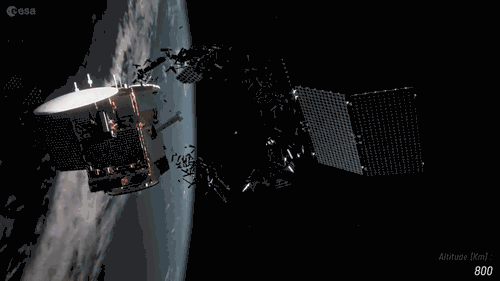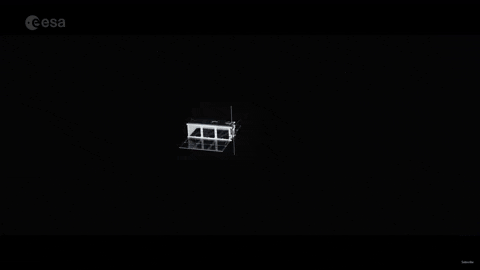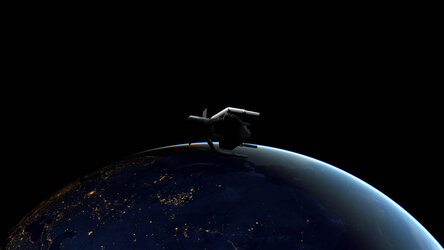Towards zero-debris CubeSats
In the past few years CubeSats revolutionised space applications in low Earth orbit, levelling the playfield and opening space to commercialisation, especially for smaller and medium companies. While their benefits are undeniable, a significant drawback is their potential to generate additional space debris. As the requirements for orbital lifetime and sustainability become more demanding, new challenges will arise for CubeSats. ESA is looking for innovative ideas to make the versatile satellites more sustainable.
ESA's Zero Debris approach seeks to significantly limit the production of debris in Earth and Lunar orbits by 2030 for all future missions, programmes and activities. According to the Agency's 2023 Space Environment report, 48.6% of satellites weighing between 10 and 100 kg do not meet current space debris mitigation standards. These satellites depend exclusively on natural decay to comply with the 25-year rule, which mandates that spacecraft must leave protected orbits within 25 years of the end of their operational life. Also, end-of-life active deorbiting systems for CubeSats have yet to be fully demonstrated.
The call is funded by the Preparation element of ESA’s Basic Activities under the SysNova initiative, which promotes joint studies by academic and industrial institutions across ESA Member States in the exploratory phase of new topics. It uses technology challenges and competition to survey a comparatively large number of alternative solutions to a proposed topic.

"CubeSats will play a major role in ensuring a sustainable development and use of low Earth orbits in the coming years", says Sibyl-Anna de Courson, systems engineer for the Clean Space Office and ESA lead of this campaign. "There is currently a global push to evolve space debris mitigation guidelines, and in the past months several new requirements have been published in this regard. Some examples are the new issue of ESA's Space Debris Mitigation regulations (SDMs), CNES' update of the French Space Operation Act (FSOA, LOS in French) and US Federal Communications Commission's (FCC) 5 year deorbiting rule," she continues. "These evolving policies mark the initial step towards achieving Zero Debris by 2030. They already raise significant challenges for CubeSats, which must rapidly adapt to cope with their transition towards a Zero Debris strategy."
The new Preparation campaign "CleanCube: Zero Debris for CubeSat platforms” offers CubeSat integrators and suppliers the opportunity to propose innovative concepts for addressing the challenges coming up in the near future, and work towards demonstrating Zero Debris capabilities for CubeSat platforms.

"The goal of this campaign is to engage CubeSat and New Space companies in the challenge of reaching Zero Debris by 2030. In particular, through this campaign we would like to collect innovative ideas, system concepts, and possible key technology development proposals, to address as many of the Zero Debris technical issues related to CubeSats as possible", says Sibyl-Anna. After the selection of the most promising ideas, the SysNova studies will serve as pre-phase A for a potential In Orbit Demonstration of Zero Debris capabilities for CubeSats.
"While several technology development activities have been undertaken to address some specific aspects of space debris mitigation for smallsats, this Preparation call on OSIP is the first activity of its kind at system level, looking to converge these developments and solutions into a platform," she adds.
What We Are Looking For

ESA is looking for ideas that include:
- CubeSat system concepts for applying Zero Debris targets to CubeSat missions. Concepts could cover, but are not limited to, solutions for reliable disposal at end of life, passivation, system resilience and monitoring, collision risk reduction, and dark and quiet skies. You are strongly encouraged to submit other system level challenges linked to Zero Debris objectives that you have identified.
- Impact analysis of new Space Debris Mitigation policies (e.g. ESA SDM standard, FCC 5-year rule, etc), including the evolution of policies and guidelines (see, for example, Zero Debris Charter targets).
- Potential business cases with a timeframe by 2030 and preliminary market analysis, taking into account environmental and economic aspects of the New Space context.
- A comprehensive development plan identifying critical technology gaps, potential solutions and scalability, and technical and programmatic challenges.
"It is important for the proposals to be compatible with a potential in-orbit demonstration (IOD) by 2027. This includes considering commercial primary missions that could benefit from the IOD. Therefore, this campaign encourages proposing and exploring potential commercial or institutional customers for the IOD," says Sibyl-Anna.
Send us your ideas

If you have an innovative idea on how to mitigate space debris for CubeSats, apply by 1 July on the OSIP campaign page. There you can also find all relevant information about the call.
Why using the OSIP platform for the Preparation call? "The evolution of CubeSat product lines toward Zero Debris can only occur within the Smallsat industry. It's crucial for CubeSat integrators to recognize and address the challenges they presently encounter in implementing Space Debris Mitigation requirements through the proposed concepts. While an initial ESA proposal outlines areas requiring development (referred to as system-level issues) in the campaign description, it's essential for companies engaged in the OSIP campaign to directly address these issues and connect them with their existing product lines and missions," says Sibyl-Anna.















 Germany
Germany
 Austria
Austria
 Belgium
Belgium
 Denmark
Denmark
 Spain
Spain
 Estonia
Estonia
 Finland
Finland
 France
France
 Greece
Greece
 Hungary
Hungary
 Ireland
Ireland
 Italy
Italy
 Luxembourg
Luxembourg
 Norway
Norway
 The Netherlands
The Netherlands
 Poland
Poland
 Portugal
Portugal
 Czechia
Czechia
 Romania
Romania
 United Kingdom
United Kingdom
 Slovenia
Slovenia
 Sweden
Sweden
 Switzerland
Switzerland






























